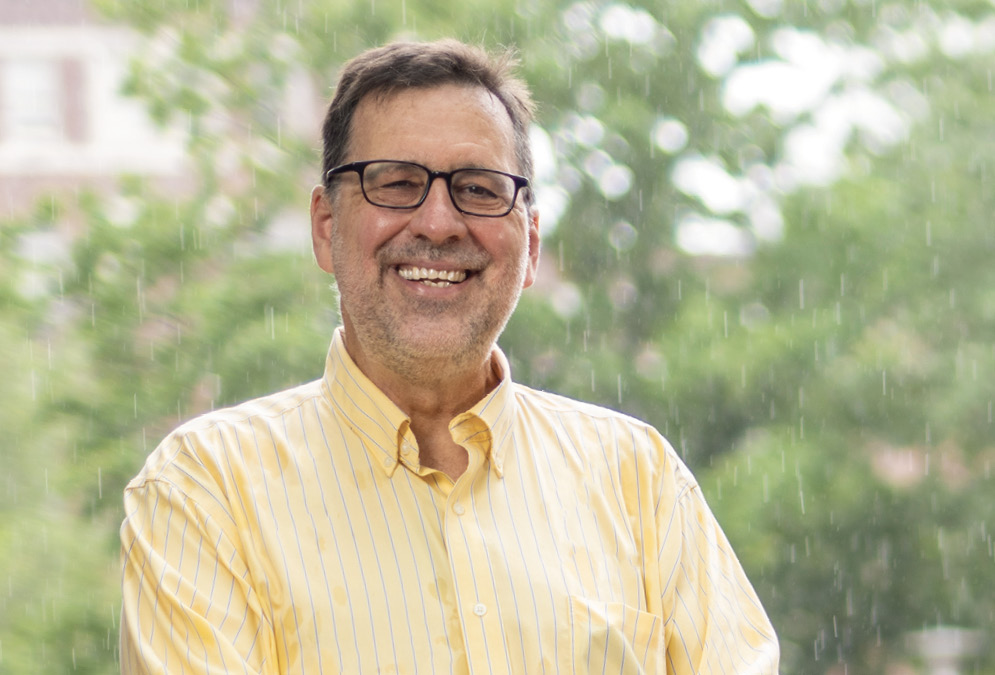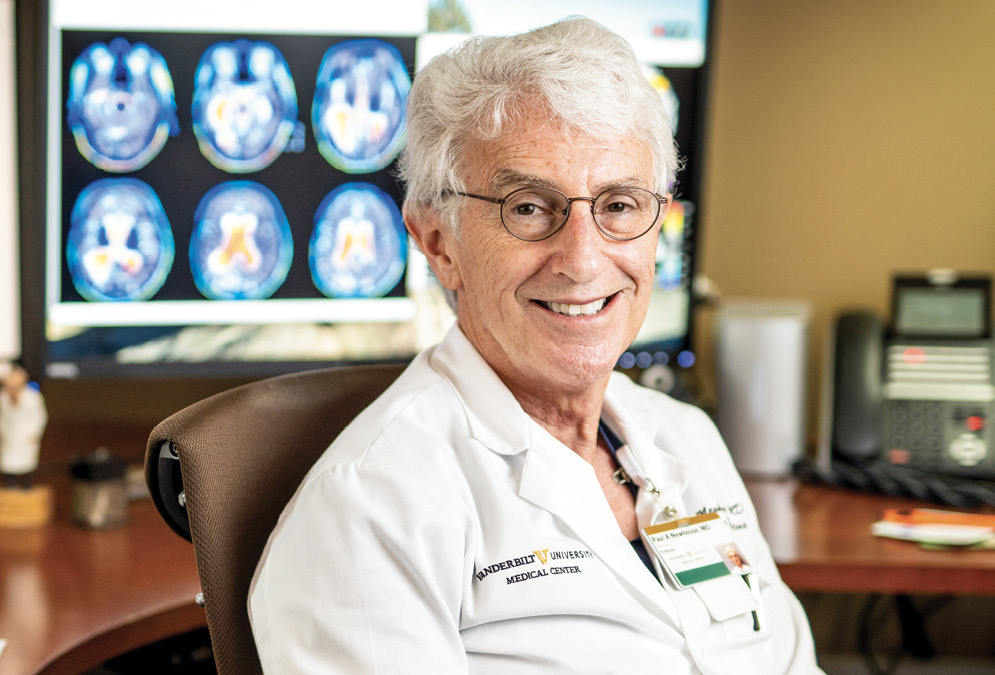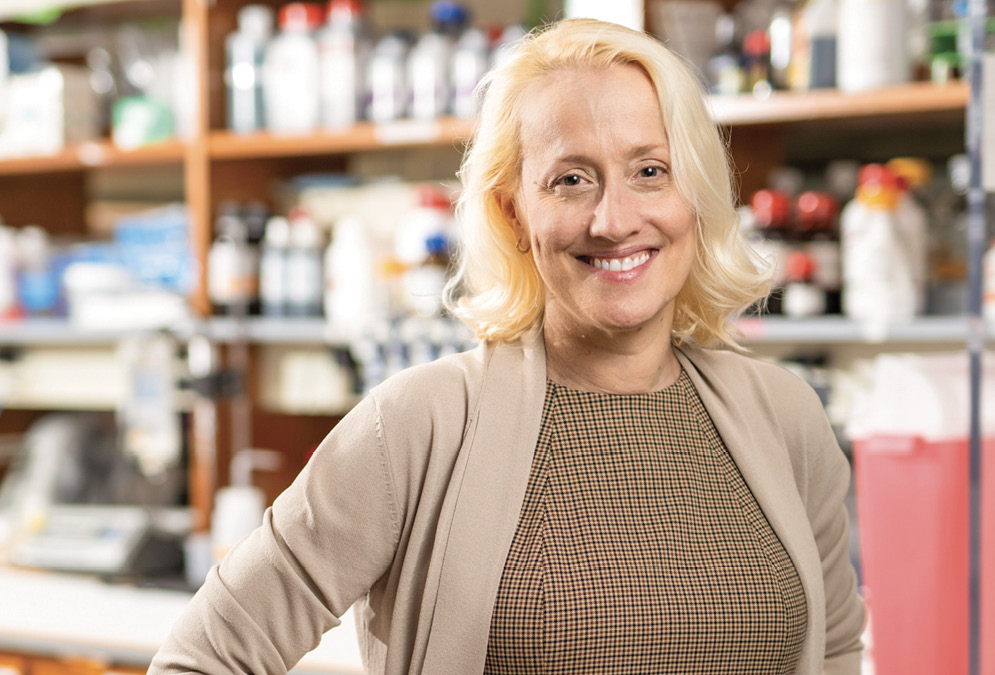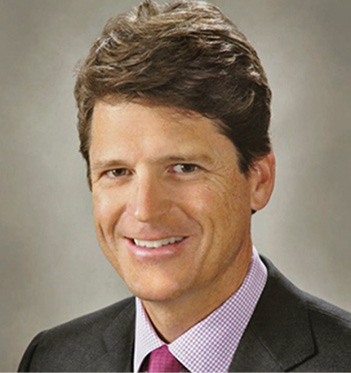By Kevin Jones

During the course of more than two years—from summer 2017 through fall 2019—52 healthy volunteers checked into the Vanderbilt Institute for Clinical and Translational Research at Vanderbilt University Medical Center to participate in a clinical trial. There they each swallowed a single capsule and underwent three-and-a-half days of around-the-clock blood tests, EKGs and other close medical monitoring, including cognitive testing. The volunteers who were not randomly assigned to receive a placebo were the first humans to ingest VU319, an investigational drug product developed by Vanderbilt researchers to target one of medicine’s most bedeviling challenges: improving memory loss in people with Alzheimer’s disease.
That first human trial to investigate the safety and tolerability of VU319 was remarkable for a couple of reasons. It was the first time Vanderbilt University had initiated a drug-discovery effort based on early basic science and advanced it into clinical trials in humans without partnering with a pharmaceutical company. And because of quirks in the system for funding drug research, and a history of failed experiments with similar medications conducted by private companies, it required extraordinary coordination among the different stakeholders involved, becoming an exercise in tenacity, teamwork and hope.
Says Carrie Jones, an associate professor of pharmacology who is part of the team developing VU319, “This story is about the right place, the right time, and the right team of scientists who came together to advance the development of a novel investigational drug product for Alzheimer’s.”
‘LIKE A DIMMER SWITCH’
More than 5.8 million Americans live with Alzheimer’s, the severe neurodegenerative disease that attacks memory and other cognitive functions. That number is expected to grow to 14 million by 2050. Today no medical therapies exist to prevent or cure the disease.
“Alzheimer’s poses an enormous scientific challenge, but there’s an abundance of exciting new ideas and fresh perspectives in the dementia research field. However, without funding for this high-risk, high-reward research, many promising novel ideas and approaches can’t move from the laboratory, through clinical trials and ultimately to patients,” says Michaela Hoag, founder and chair at the Alzheimer’s Association Part the Cloud global research grant program. The organization recently teamed with philanthropist Bill Gates to accelerate scientific progress in Alzheimer’s research by funding the most promising early phase studies. Hoag and her husband, Jay, a member of the Vanderbilt Board of Trust, are the parents of recent graduates Sean Hoag, BS’15, and Samantha Hoag, BA’17.

The lack of an effective treatment prompted Vanderbilt researchers in the late 1990s to begin working toward development of a potential Alzheimer’s drug. By 2008 the work had moved to what is now known as the Warren Center for Neuroscience Drug Discovery at Vanderbilt (see sidebar below), where founder and co-director Jeffrey Conn, PhD’86, the Lee E. Limbird Professor of Pharmacology, and his fellow scientists identified and optimized the specific molecule that the university eventually would patent as VU319.
The brain comprises tens of billions of nerve cells called neurons, and activity takes place via nerve impulses carried by chemicals called neurotransmitters. One of them, acetylcholine, is thought to help regulate learning and memory.
In the early stages of Alzheimer’s, before wide-scale neuron loss occurs, neurons that produce acetylcholine begin to fail. VU319 is designed to amplify the response to the acetylcholine that is released from remaining functional neurons, specifically by increasing sensitivity of the M1 muscarinic acetylcholine receptors. Amplifying this response could make a difference not only for Alzheimer’s patients but also for people with memory loss seen in other diseases such as schizophrenia.
“Back in the 1990s, a number of companies developed selective activators for this receptor, and they were all unsuccessful,” Conn explains. Side effects like excessive salivation, diarrhea and watery eyes made those medicines impractical at doses high enough to potentially improve memory.
Conn, then a researcher in the pharmaceutical industry, wondered if it might be possible to refine the concept. Could a receptor’s response to acetylcholine be fine-tuned just enough to help stave off memory loss without triggering adverse effects?
First at Merck and then at the WCNDD, Conn and his colleagues focused on identifying small molecules that could target the M1 by selectively binding to a particular part of the receptor. The technical term for such a molecule is positive allosteric modulator, or PAM, and “modulate” is the key idea.
“Those early activators were more like a switch that turned the receptor on or off,” Conn explains. “Our approach was to develop one that acts more like a dimmer switch and ‘turns up’ receptivity.”

Medicinal chemist and WCNDD co-director Craig Lindsley, who also worked in the pharmaceutical industry before joining Vanderbilt, notes that the molecule that eventually became VU319 was at first problematic enough that, at a pharmaceutical company, it would have been “triaged out” because its imperfections made it too risky and time-consuming to invest in.
“Management would have said, ‘Don’t pursue that,’” says Lindsley, University Professor of Pharmacology, Biochemistry and Chemistry, and holder of the William K. Warren Jr. Chair in Medicine.
Thanks to timely technological advancements that allowed for dramatically faster identification of desirable molecular properties, Lindsley and his graduate students were able to refine the molecule so that it could zero-in on the M1 in the way they had hoped. Later testing on animals indicated the concept could work.
“When we saw that this new approach allowed us to avoid adverse effects in animals,” Conn says, “it was really exciting, and it gave me the confidence that we weren’t going to see those side effects in humans.”
ENTER FATE … AND FORTUNE
Once VU319 emerged as a candidate for testing, its developers faced a new challenge: funding. A grant from the National Institutes of Health had provided financial support for the early basic science and discovery of VU319, but NIH money typically does not support the preliminary investigations required by the U.S. Food and Drug Administration to initiate clinical trials.
“Alzheimer’s poses an enormous scientific challenge, but there’s an abundance of exciting new ideas and fresh perspectives in the dementia research field.”
“We call it the ‘valley of death,’” Lindsley explains. “You have a great clinical candidate, but there’s no way to get funding for clinical development. You’re stuck.”
Usually at this point, universities partner with a pharmaceutical company. Private companies have not only the resources to conduct clinical testing but also the expertise to navigate the FDA’s strict and complicated approval process. But because of the disappointing work with similar drugs in the 1990s, pharmaceutical companies were reluctant to take a chance on VU319. So, the WCNDD decided to go it alone, without a private partner.
In 2012, as the team was puzzling over how to move forward, Lindsley traveled to Tulsa, Oklahoma, to give a talk at the Warren Foundation’s Laureate Institute for Brain Research—the same foundation that had endowed his chair in medicine. At the end of the presentation, philanthropist William K. Warren Jr. himself stood and asked Lindsley what the researchers could accomplish with a multimillion-dollar donation.
“With drug discovery, hard work and creativity drive a lot of it, but at the end of the day, if you don’t have luck on your side, you’re in trouble,” Lindsley says. “That moment at the Warren Foundation is where fate and fortune really came into play.”
The Vanderbilt group used part of the $8 million ultimately donated by the foundation to the center to hire what Carrie Jones calls a “dream team” of consultants who guided the WCNDD through the unfamiliar, multiyear process of conducting FDA-required toxicology studies and completing the application for an investigational new drug. The final application filled 15 binders, each half a foot thick. Jones, who conducted related research at a pharmaceutical company before Conn recruited her to the WCNDD, managed the whole daunting process. The FDA had 30 days to allow the study to proceed or reject the WCNDD’s application. It approved it in just 20.

After notification from the FDA that the study could proceed, the WCNDD team turned to Dr. Paul Newhouse, director of the Center for Cognitive Medicine at Vanderbilt University Medical Center and a 30-year veteran of research into cognitive disorders, to design the testing protocols and supervise the study. Newhouse also was instrumental in securing additional funding for the trial from the Alzheimer’s Association and the Alzheimer’s Drug Discovery Foundation. The “single ascending dose” (or “SAD”) study trial’s objective: to see if healthy humans could tolerate a single dose of VU319 without side effects.
Over nearly two years, starting in 2017, volunteers were given single ascending doses of a compound containing VU319 and monitored for 36 hours. Medical and research staff continually tested volunteers’ cognitive functions, monitored their vital signs and more.
“It was a labor-intensive, high-intensity study,” says Newhouse, the Jim Turner Professor of Cognitive Disorders and professor of psychiatry and behavioral sciences, medicine and pharmacology. He says he and his colleagues are “cautiously encouraged” by the results. The volunteers taking VU319 did not experience significant adverse effects like those triggered by earlier investigative drugs—and some showed signs of cognitive improvement.
“The activity we see so far is indicative of the molecule hitting the right target in the brain,” Newhouse says.
A COLLABORATIVE CAMPUS
Another ingredient in VU319 has been just as important to its progress as the molecule Conn and Lindsley engineered: collaboration among Vanderbilt’s institutions, which Conn calls “absolutely essential.”
“When I was considering what I needed to start an academic drug discovery center, Vanderbilt was the only institution I met with that had the culture to make it possible.”
“When I was considering what I needed to start an academic drug discovery center, Vanderbilt was the only institution I met with that had the culture to make it possible,” Conn says. “Inside and outside WCNDD, it’s a very collaborative, multidisciplinary culture with team-oriented science.”
Jones agrees: “At Vanderbilt, if you have a great idea, you walk across the street and talk to a potential collaborator. That’s how it started with Paul Newhouse at the Medical Center. We didn’t have to have a big committee meeting like in the industry.
“Collaboration here isn’t siloed—it’s completely horizontal, and it’s one of the most exciting translational environments I’ve ever worked in.”
That collaboration extends to the university’s leadership, Jones notes. “In particular, Provost and Vice Chancellor for Academic Affairs Susan R. Wente, Vice Provost for Research Padma Raghavan, and Dean of Basic Sciences Larry Marnett—they’ve all said, ‘We must provide an environment in which faculty’s basic science can translate to the next generation of drugs.’ And they didn’t just say it, they put it into practice.”
With the SAD study completed, the VU319 team is now preparing for the “multiple ascending dose” (or “MAD”) study, in which a new group of volunteers will spend a full week receiving daily doses of VU319—again, to ensure that the human body can tolerate it without significant side effects. The team also will conduct biomarker studies to see if promising signals of cognitive improvement continue to appear.
If that test goes well, VU319 will undergo further study to establish definitively whether it is effective and safe. Cumulatively, that will involve thousands of Alzheimer’s patients and could take about eight years.
The WCNDD announced in June that it has entered into an exclusive worldwide licensing and collaboration agreement with San Diego-based ACADIA Pharmaceuticals Inc., which will seek to develop and commercialize treatments for central nervous system disorders, such as Alzheimer’s and schizophrenia—including VU319. The pharmaceutical maker’s expertise will be vital, particularly in funding further work.
The cost of a multisite trial in Alzheimer’s patients, explains Newhouse, could exceed $100 million, compared to the roughly $1.5 million that the first trial cost. “The clinical trial costs end up dwarfing the costs for drug discovery and development.”
SCIENCE FOR THE GREATER GOOD
The road to a game-changing drug for a disease as intractable as Alzheimer’s is long, winding, and not for those without resilience. Dead ends and disappointments are common. In February of this year, hopes were dashed when another promising clinical trial of a different Alzheimer’s drug, led by researchers at Washington University School of Medicine in St. Louis, ended in failure.

Conn, Lindsley, Jones and Newhouse all emphasize that it is too early to know anything conclusive about VU319’s efficacy, or even its long-term safety. Yet all are pleased by the progress they have made on a journey that started more than a decade ago.
“A lot of people told me that developing modulators with this kind of selectivity would never work,” Conn says. “So, the success we’ve had to date has been very exciting.”
Maybe even more important, the team’s success points to the role that Vanderbilt and other universities might increasingly play in developing neuropsychiatric therapies, as many drug companies pull back from much-needed drug discovery.
“Academic drug discovery groups are absolutely critical for de-risking novel drug mechanisms, given major pharma’s reticence about investing,” Jones says. And even if promising ideas like VU319 do not turn out to be a cure, the science behind them can pave the way to one, by shedding more light on the subject and reducing risk so that companies might take a chance on a new drug.
Says Lindsley, “Whether or not our compound becomes the drug, if our data sets encourage companies to start their own programs, or develop their own molecules, we can still claim that as a win. However the drugs get to society, whether by our hand or by the influence of our work, it’s worth it in the end.”
Kevin Jones is a Seattle-based writer who writes for corporations, nonprofits and universities. His work often focuses on sustainability, corporate social responsibility and higher education.
$20M gift establishes new Warren Center for Neuroscience Drug Discovery
The university has received $20 million from The William K. Warren Foundation in Tulsa, Oklahoma, to establish the Warren Center for Neuroscience Drug Discovery at Vanderbilt University.
Formerly known as the Vanderbilt Center for Neuroscience Drug Discovery, led by co-directors Craig Lindsley and Jeffrey Conn, PhD’86, it currently includes approximately 100 renowned scientists with a diverse set of interests and skills working to translate essential research ideas into viable new drug treatments that prevent serious brain disorders, like Alzheimer’s disease, schizophrenia and Parkinson’s disease.
One of the more promising compounds, VU319, developed by Vanderbilt researchers and sponsored by the Warren Foundation, could help slow memory loss accompanying various cognitive diseases. (See main article.)
The William K. Warren Foundation was founded in 1945 by oilman William Kelly Warren and his wife, Natalie Overall Warren, who graduated from Vanderbilt (1920) and shared that distinction with her father (1885) and her four siblings. The Warren Foundation established Oklahoma’s largest health care provider, the Saint Francis Health System, and the Laureate Institute for Brain Research in Tulsa. The foundation supports health care innovation, medical research, Catholic initiatives, education and Tulsa-specific causes.

“We have been impressed with the creative approaches and hard work demonstrated by Vanderbilt researchers, especially Craig and Jeff, in the Center for Neuroscience Drug Discovery,” says John-Kelly Warren, CEO of the Warren Foundation and grandson of the founders. “Supporting novel, research-based methods to combat devastating cognitive impairments and mental illnesses lies at the heart of our foundation’s mission. It is also gratifying to support this research at Vanderbilt University, an institution that has made a significant impact on the lives of so many, including my family.”
In addition to supporting research efforts, part of the Warren gift will be used to create an endowment designed to encourage mentorship and the development of a long-term pipeline of research leaders.
“Genuine breakthroughs sometimes require taking paths that may not seem promising—or at least commercially viable—in the earliest stages of scientific investigation,” says Lindsley, who holds the William K. Warren Jr. Chair in Medicine. “The support of philanthropic organizations like the Warren Foundation is critical to making discoveries that may not otherwise see the light of day and translate them to the clinic.”
In addition to this latest commitment, the Warren Foundation has been a longstanding supporter of Vanderbilt and its research efforts. Seven endowed faculty chairs currently are supported by the foundation—ranging in disciplines from medicine and pediatrics to divinity—and the William K. Warren Foundation Scholarship is awarded to deserving undergraduates in the College of Arts and Science.
—RYAN UNDERWOOD, BA’96